Abstract
Nanofluids are considered as an effective way to enhance the thermal conductivity of heat transfer fluids. Additionally, the involvement of micro-organisms makes the liquid more stable, which is important in nanotechnology, bio-nano cooling systems, and bio-microsystems. Therefore, the current investigation focused on the examination of the thermodynamic and mass transfer of a Carreau–Yasuda magnetic bionanomaterial with gyrotactic micro-organisms, which is facilitated by radiative peristaltic transport. A compliant/elastic symmetric channel subject to partial slip constraints was chosen. The features of viscous dissipation and ohmic heating were incorporated into thermal transport. We use the Brownian and thermophoretic movement characteristics of the Buongiorno nanofluid model in this study. A set of nonlinear ordinary differential equations are created from the partial differential equations that control fluid flow. The governing system of differential equations is solved numerically via the shooting technique. The results of pertinent parameters are examined through velocity, temperature, motile micro-organisms, concentration, and heat transfer rate.
1. Introduction
Peristalsis is the term that refers to the movement of fluid caused by wave motion that is influenced by the sinusoidal wall of a channel or duct. The pharmaceutical, bioengineering, facelifts, chemical, and paper industries all depend on the peristalsis process. Additional examples of peristaltic procedures in living organisms include the flow of sperm, ovum, urine, blood, food, and other bodily fluids. Peristaltic pumps are used in medical devices, such as fusion pumps, open-heart bypass pumps, and dialysis machines. With these issues in mind, Latham [1] conducted an earlier survey of peristaltic movement using both theoretical and empirical research methods. Since then, numerous researchers have looked into a variety of peristalsis-related topics in different flow circumstances. The small Reynolds number and large wavelength assumption with peristaltic pumping were later expanded by Shapiro et al. [2]. Mekheimer [3] has explored the features of the magnetic aspects for the peristalsis of couple stress fluids. Ali et al. [4] examined the thermal analysis for peristaltic in a curved channel. Wall characteristics for peristaltic transport of nanomaterial were studied by Mustafa et al. [5]. Hayat et al. [6] scrutinized the hall and convective aspects peristaltic flow of couple stress fluids. Sinnott et al. [7] inspected the particulate deferment in the small intestine, considering the activity of peristalsis. Yasmin et al. [8] studied the aspects of peristaltic transport with hall current and convective conditions. Nisar et al. [9] explored the characteristics of compliant walls and thermal radiation for the peristaltic flow of nanoliquids. Yasmin et al. [10] examined the peristaltic flow of Johnson–Segalman fluids. Hina et al. [11] inquired about the peristaltic motion of non-Newtonian nanomaterials, considering the features of the electro-osmotic flow. Abbasi and Shehzad [12] developed a numerical solution for the peristaltic activity for ethylene-glycol and boron-nitride nanomaterials with a curved channel. Fluids with slip consequences have a wide spectrum of uses, including the buffing of artificial heart valves and inbuilt cavities. Slip aspects with peristaltic motion can be cited via [13,14,15].
Researchers and engineers became interested in assessing the flow of nanofluids for the advancement of the transport of heat. Nanofluids are used in a wide variety of industries and manufacturing fields, including microelectronics, geothermal panels, lubricating oil, nuclear reactors, biomedicine, pharmacological treatments, transportation, transformers, scintillating heat pipes, electronic devices, coolant in computers, lubricants in vehicles, nano-medicines, drug delivery, fermentation science, rubber sheet, factory production, heat exchanger design, and power generation. Due to its vast convenience, scientists and researchers have investigated nanomaterials as a result of their applications in various arenas of manufacturing and scientific processing. Choi and Eastman [16] coined the term “nanofluid” to characterize the use of conventional fluids with nano-sized diameters of less than 100 nm. Buongiorno [17] then gave a full investigation of nanofluids, in which he examined how Brownian movement and thermophoretic dispersion of nanoparticles lead to an increase in thermal conductivity. Tsai et al. [18] examined the effectiveness of gold nanoparticles in the thermal performance of heat pipes. Li et al. [19] examined the detailed analysis of nanofluids. Yan et al. [20] studied the speed of nanoparticles in nanomaterials via a zero-crossing laser speckle technique. Abbasi et al. [21] scrutinized the activity of peristalsis with copper-water nanofluids through permeable space. Akram et al. [22] reported the consequences of a magnetic field of a peristaltic pseudoplastic nanoliquid via a trapped channel. Bhatti and Abdelsalam [23] investigated the peristaltic activity of a hybrid nanofluid containing gold nanoparticles and tantalum while also considering its magnetic factors. Alsaedi et al. [24] reported the mixed convection and complaint wall characteristics for peristaltic flow for a nanofluid. Abbasi et al. [25] analyzed the electro-osmosis peristaltic flow of a hybrid nanofluid. Nisar et al. [26] reported the numerical investigation peristalsis of couple stress nanomaterials. Hussain et al. [27] examined the peristaltic flow of hybrid nanofluids. In their study, they analyzed how to enhance thermal conductivity with electro-osmosis-modulated peristaltic flow. Yasmin et al. [28] examined how hybrid nanofluids are useful in solar and thermal energy storage.
Bionanomaterials are nanoscale substances that are produced biologically. They display distinctive chemical, structural, optical, physical, electrical, biological, and mechanical features that set them apart from bulk matter due to their very compact size. Bionanomaterials, e.g., fungi, bacteria, plants, nucleic acids, peptides, etc., are promising materials made from numerous biological components. Due to their biological synthesis and biocompatibility, the use of bionanomaterials in the biomedical area has received considerable interest. Bionanomaterials, which are extraordinarily small, have unique qualities that give them potential in a variety of fields, including pharmacology, aeronautical engineering, material science, biosensors, and more. Moreover, a number of characterization techniques have been used to explore the characteristics of the synthesized bionanomaterials [29,30].
Numerous scientists and researchers have become fascinated by the study of non-Newtonian fluids in recent years. Studies on these fluids are encouraged by their significance in fields including industrial developments, plastic melting, pharmaceutical products, polymeric fluids, metabolic engineering, hazardous and nuclear facilities, industrial settings, and the food industry. Blood, perfumes, honey, diesel fuel, glue, cream, and many more substances are famous examples. Among these, the Carreau–Yasuda fluid framework [31] can explain the shear thinning and thickening features. Kayani et al. [32] examined the peristaltic flow of the Carreau–Yasuda model by adding nanoparticles. Khan et al. [33] examined the entropy generation analysis for a Carreau–Yasuda material with activation energy. Hayat et al. [34] explored the impact of modified Darcy’s expression for peristaltic motion of Carreau–Yasuda nanoliquids via a chemical reaction. Iqbal and Abbasi [35] studied the MHD peristaltic activity of nanoliquid by analyzing a Carreau–Yasuda model via joule heating and variable thermal conductivity.
Bioconvection is the term used to describe organic macroscopic convective fluid motion. The bioconvection phenomenon is caused by the interaction of micro-organisms at various physical scales. The presence of directional movement of different types of micro-organisms is a prerequisite for various bioconvection systems. Gyrotactic micro-organisms are those that travel in water against the direction of gravity. The base fluid density is increased by these gyrotactic bacteria when they swim in a certain direction. Bioconvection is essential to bioengineering and bioimaging. According to the available data, several scientists have employed various bioconvection models to examine bioconvection movement mechanisms. Pedley et al. [36] studied the growth of bioconvection models in a uniform suspension of gyrotactic micro-organisms. Waqas et al. [37] examined a second-grade nanoliquid, including its gyrotactic micro-organisms. Rao et al. [38] explored the effects of gyrotactic micro-organisms for bioconvection in a convectional nanofluid. Hayat et al. [39] examined the slip and bioconvection aspects of the peristalsis of nanomaterials. Hussein et al. [40] discussed the bioconvective peristaltic flow of Jeffrey nanofluids. Akbar et al. [41] analyzed the peristaltic motion for motile gyrotactic micro-organisms of Eyring Powell nanoliquids. Avramenko et al. [42] reported the aspects of bioconvection instability of gyrotactic motile micro-organisms.
One of the areas of coating research that has had its fair share of successes and failures is compliant walls. The topic has fascinated, perturbed, and occasionally contented engineers and scientists for the past four decades as they search for ways to forgo the transition from laminar to turbulent flow, suppress flow-induced noise, reduce skin-friction drag in turbulent wall-bounded flows, and suppress vibrations [43,44]. The findings of Kramer [45] showed a compliant coating design based on dolphin epidermis, with reports of remarkable transition delay and drag reduction in hydrodynamic flows, which is what initially sparked interest in the topic. Regarding the dependability of the available analytical, numerical, and experimental data, there are several significant problems.
The present investigation looks at the impacts of bioconvective magnetohydrodynamic peristaltic Carreau–Yasuda bionanomaterials in a symmetric channel with gyrotactic micro-organisms. Compliant/stretchy channel walls are subjected to slip boundary conditions. A Carreau–Yasuda nanofluid is used in this study with integrated features of random motion and thermophoresis. The aspects of thermal radiation and ohmic heating are also considered. Numerical solutions for velocity, nanoparticle concentration, temperature, and motile micro-organism profiles were found. Finally, the key findings of the study are listed. This is a study that might be very useful in the field of biomedical and nanotechnology.
2. Problem Formulation
We consider two-dimensional peristaltic flow of a Carreau–Yasuda nanofluid. Here, we choose a symmetric channel of width A Cartesian co-ordinate system is used, such that the axis and axis are transverse and parallel to the channel walls. The motion of gyrotactic micro-organisms, which constitutes bioconvection, preserves the nanoparticles suspended in the nanofluid. The channel is subjected to a () constant magnetic field that is applied perpendicularly. The elastic walls are traversed by sinusoidal waves. The wall shapes are defined by [5].
where λ, c, and a denote wavelength, wave speed, and amplitude, respectively. The related expressions for Carreau–Yasuda fluid S are defined by [31,32].
From (3), and represent the infinite and zero share rate viscosities. In the present study, we assumed that is zero. Further, and are the material variables. Additionally, represents the power law index. The expression is the first Rivlin Ericksen tensor. The thermal transfer incorporates thermophoresis and Brownian motion. The expressions for the problem under these assumptions are as follows:
The subjected boundary conditions are
In the above equations, designate the components of velocity in the plane, is the density of the nanoparticles, is the nanofluid density, is the motile micro-organisms density, is gravity, is the micro-organisms diffusion coefficient, is for kinematic viscosity, is for electric conductions, is for pressure and is for thermal diffusivity, and is for viscous damping coefficient. Further, describes the thermophoretic diffusion and Brownian movement coefficient, , , for the ratio of the liquid’s heat capacity to the material’s effective heat capacity, is the average volume of the micro-organisms, is the chemotaxis constant, is the tension of the elastic, is the maximum cell-swimming speed, is the area per unit mass, is the mean temperature, and are the concentration and temperature at the top and lower walls, respectively. Further, is the fraction volume at the upper and lower walls. The radiant heat flow satisfies the Rossland approach:
where are the constant of the Stefan–Boltzman coefficients and mean absorption, respectively. The expanded form of can be written as
thus, we have
When considering stream function and using the nondimensional variables:
in Equations (5)–(13). After omitting the asterisk, we can write
The boundary conditions become
The continuity in Equation (5) is automatically satisfied. In the above expression, we witnessed that the small Reynolds number and large wavelength suppositions [2] are invoked. Here, Re and are ratio of amplitude, wave number, Eckert number, Reynolds and Prandtl numbers, Hartman number, Schmidt number, Brinkman number, Brownian motion variable, thermophoresis parameter, Weissenberg number, radiation parameter, elasticity parameters, concentration Grashof variable, Bioconvection Peclet number, Bioconvection Grashof number, thermal Grashof number, and viscosity ratio parameter, respectively. These are defined by
3. Numerical Method
The system constituting Equations (18)–(21) with the associated boundary conditions (22)–(24) are solved numerically via the shooting method by the program NDSolve using the fourth-order Runge–Kutta algorithm with the help of Mathematica. This approach helps with tiny step size errors and small errors and has strong internal consistency for boundary value problems.
4. Results and Discussion
The results for velocity, temperature, and the profiles of the motile micro-organisms were examined graphically. Further, the nanoparticle concentrations and rates of heat transfer were scrutinized by tabling the results.
4.1. Velocity
The consequences of the relevant parameters for velocity are presented in Figure 1, Figure 2, Figure 3, Figure 4, Figure 5, Figure 6, Figure 7 and Figure 8. The effect of the velocity slip parameter, , is depicted in Figure 1. It was noticed that the velocity of the fluid arises via the velocity slip parameter Figure 2 demonstrates the aspects of the Grashof number, against velocity. An enhancement in temperature is observed against the Grashof number . The sketch of the bioconvection Rayleigh variable, is illustrated in Figure 3. As we can see, the velocity of the fluid declines with a larger The features of the buoyancy ratio variable, on the velocity profile are shown in Figure 4. The graph represents how the boosts fluid velocity. The impacts of the Hartman number, on the velocity are revealed in Figure 5. This graph makes it clear that the liquid’s velocity is decreasing. The implications of the bioconvection Peclet number on the velocity profile can be seen in Figure 6. The observed outcomes show that a rise in increases the velocity. The impact of the Weissenberg number, is portrayed against velocity (see Figure 7). In this figure, we can see that the velocity of the liquid increases. The wall parameters and are exhibited in Figure 8. It was detected that velocity is an increasing function of and and it decreases for in view of the damping effect.
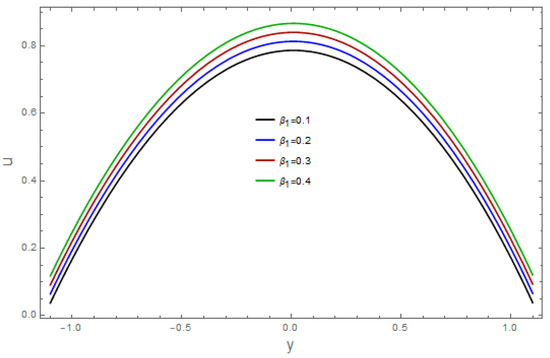
Figure 1.
Effect of β1 on u.
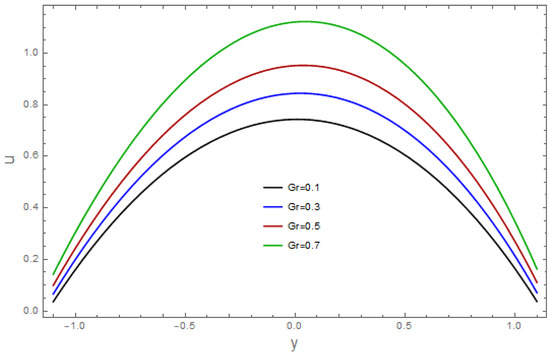
Figure 2.
Effect of Gr on u.
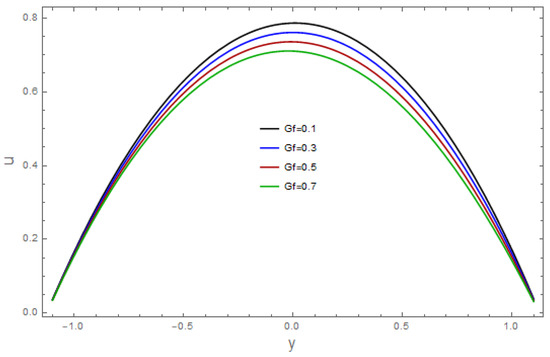
Figure 3.
Effect of Gf on u.
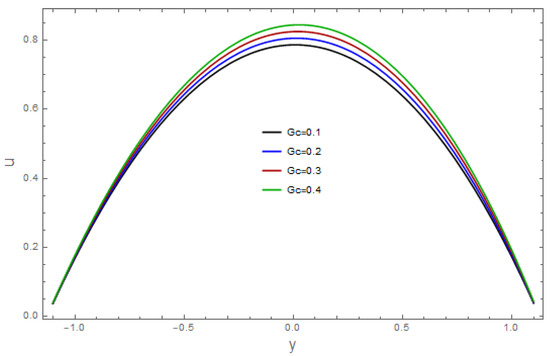
Figure 4.
Effect of Gc on u.
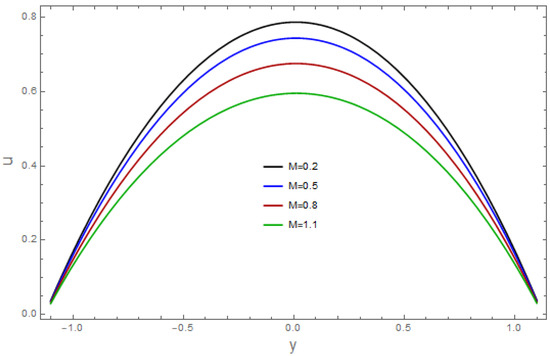
Figure 5.
Effect of M on u.
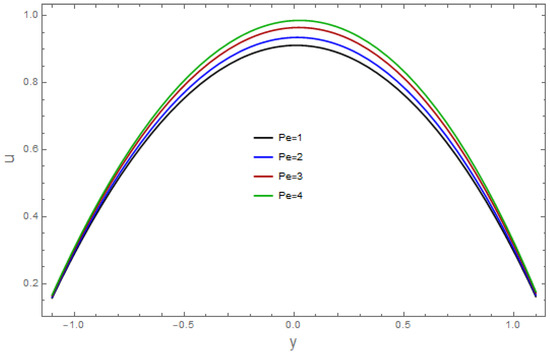
Figure 6.
Effect of Pe on u.
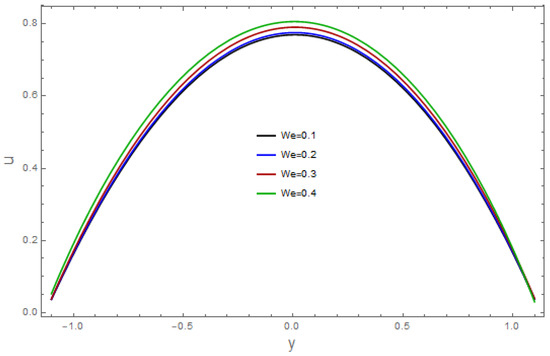
Figure 7.
Effect of We on u.
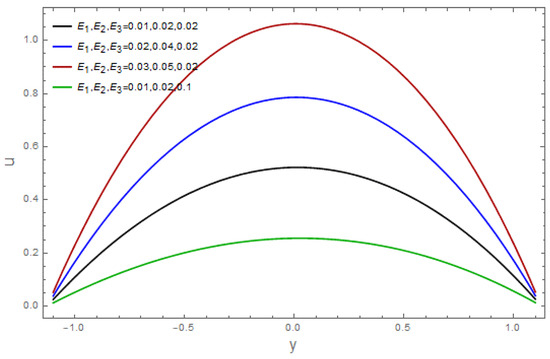
Figure 8.
Effects of E1, E2 and E3 on u.
4.2. Temperature
The influence of various pertinent parameters on temperature is captured through Figure 9, Figure 10, Figure 11, Figure 12, Figure 13, Figure 14, Figure 15, Figure 16 and Figure 17. Figure 9 represents the outcomes of the bioconvection Rayleigh parameter, with temperature. The temperature of the fluid declines as the bioconvection Rayleigh variable, increases. The influence of the Grashof number, on temperature is displayed in Figure 10. As we can see, increasing the values of causes the material’s temperature to increase. Figure 11 depicts the thermal field against the Brownian movement variables With increasing Brownian diffusion, , the average kinetic energy of the fluid increases. As a result, the temperature acclivities. Figure 12 depicts the effect of the thermal radiation parameter on the temperature. This graph demonstrates that the temperature declines when the radiation variable, Increases. Figure 13 portrays the impressions of the Brinkman variable, on the temperature. As a high Brinkman variable, intensifies, the outcomes of the viscous dissipation results in temperature acclivities. The impact of the thermal slip parameter, is shown via Figure 14. By enhancing the values of the thermal slip parameter, we can see that temperature increases. The effects of the buoyancy ratio variable, are displayed in Figure 15. An increasing trend is noticed for temperature vs. the buoyancy ratio variable The thermal field vs. the Weissenberg number, is shown in Figure 16. The temperature decreases as the mass Weissenberg number, increases. The consequences of the wall parameters , and are presented in Figure 17 for temperature. It is shown that temperature is an increasing function of and and it decreases with in view of the damping outcome.
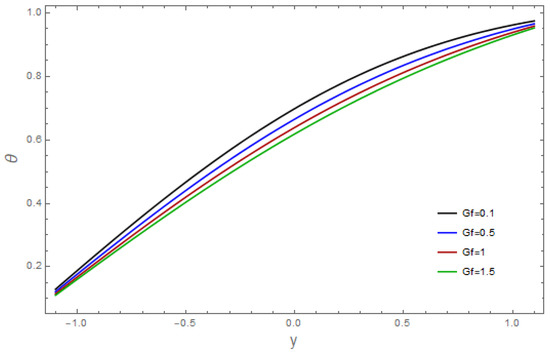
Figure 9.
Effect of Gf on θ.
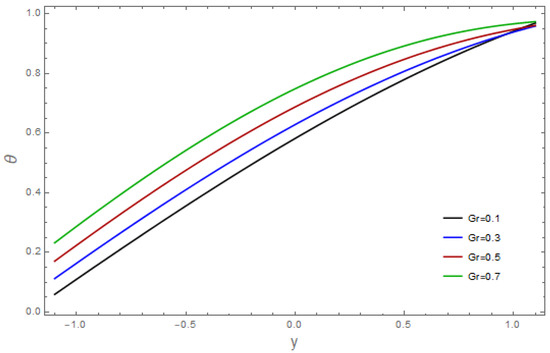
Figure 10.
Effect of Gr on θ.
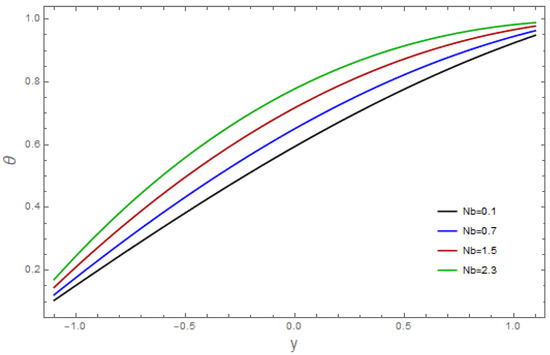
Figure 11.
Effect of Nb on θ.
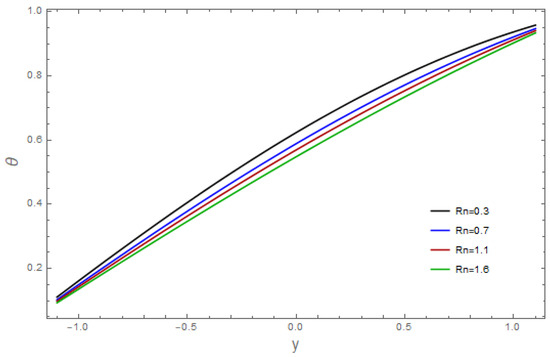
Figure 12.
Effect of Rn on θ.
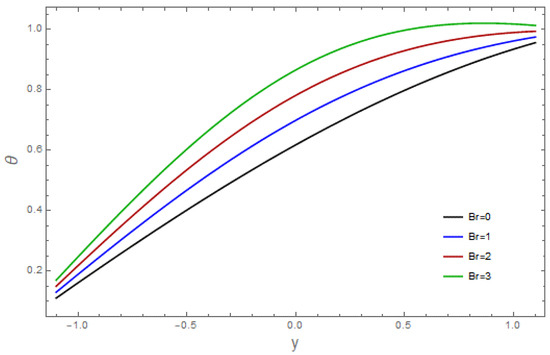
Figure 13.
Effect of Br on θ.
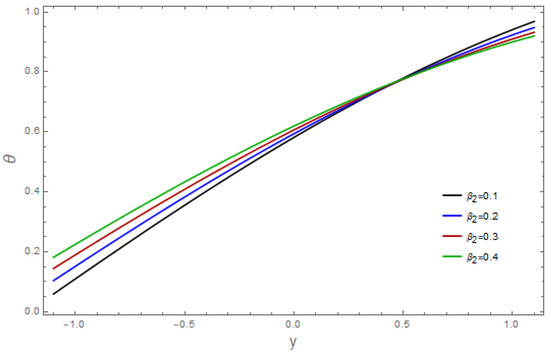
Figure 14.
Effect of β2 on θ.
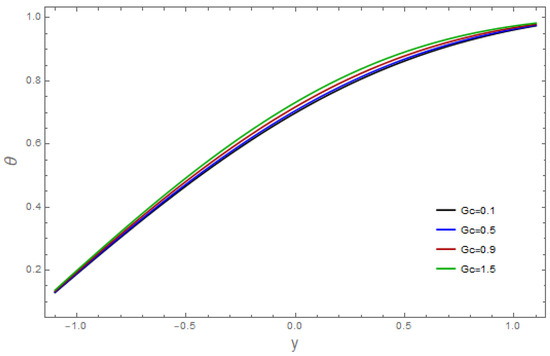
Figure 15.
Effect of Gc on θ.
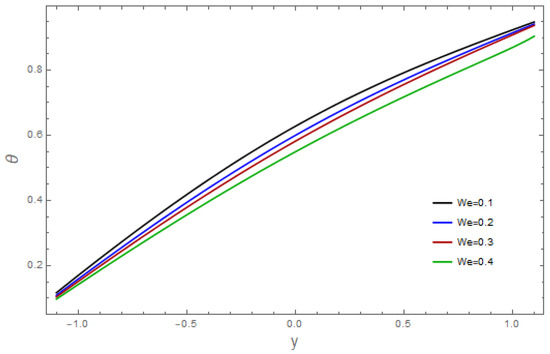
Figure 16.
Effect of We on θ.
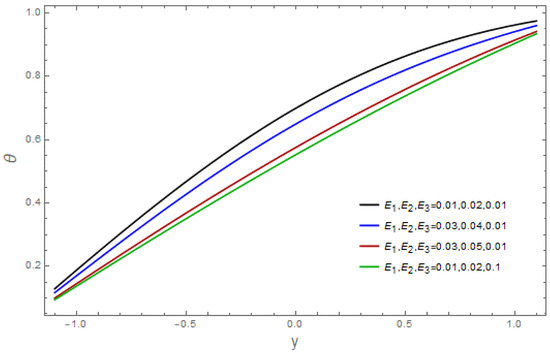
Figure 17.
Effects of E1, E2 and E3 on θ.
4.3. Profiles of Motile Micro–Organisms
Figure 18, Figure 19, Figure 20, Figure 21 and Figure 22 show the influence of the measured variables on the profiles of the motile micro-organisms . The influence of the bioconvection Peclet number, is presented in Figure 18 against the motile micro–organisms profiles. It is shown that the motile micro–organisms profiles decline with an increasing bioconvection Peclet number Figure 19 presents the results for . The motile micro–organisms profile increases with increases in The impact of the thermophoresis variable, on the profile of the motile micro–organisms is displayed in Figure 20. An increment in the thermophoresis variable, decreases the profile of the motile micro–organisms. The bioconvection Rayleigh variable, is exhibited in Figure 21. From this figure, it can be seen that the motile micro–organisms profile, decreases for the bioconvection Rayleigh variable Figure 22 shows the Weissenberg number . As can be seen in this figure, the micro–organisms profile, of the fluid declines via the Weissenberg number
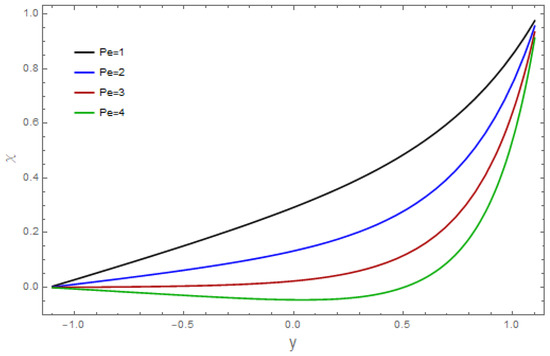
Figure 18.
Effect of Pe on χ.
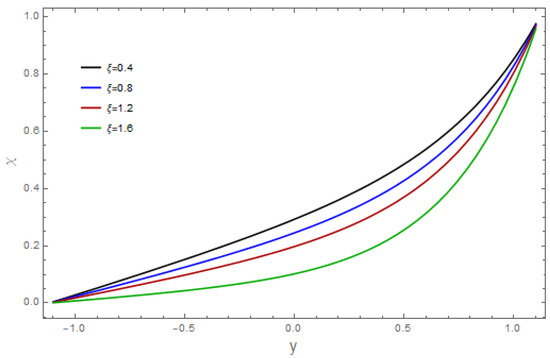
Figure 19.
Effect of ξ on χ.
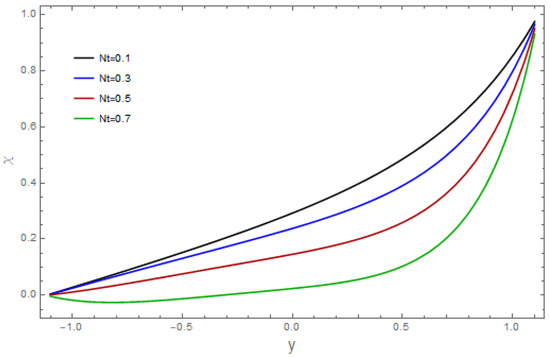
Figure 20.
Effect of Nt on χ.
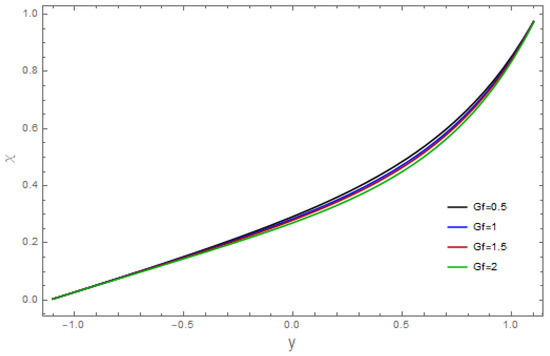
Figure 21.
Effect of Gf on χ.
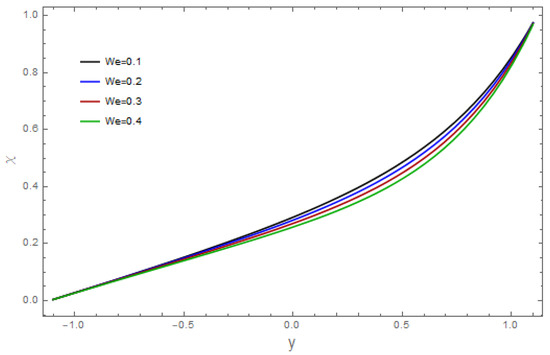
Figure 22.
Effect of We on χ.
4.4. Concentration
The impacts of different pertinent variables, like and on concentration are displayed in Table 1. The concentration field decreases in the presence of By enhancing the values of the mass slip variable, the concentration decreases. It is observed that the concentration field is an increasing function of the Rayleigh variable The concentration of the nanofluid decreases as the value of the buoyancy ratio parameter, increases. In the presence of the bioconvection Peclet number, the concentration field decreases. The concentration of the nanofluid has the opposite behavior for the thermophoresis, and Brownian movement, variables.

Table 1.
Influences of distinct physical variables on ϕ(0).
4.5. Heat Transfer Rate
The influence of the sundry variables on the rate of heat transfer, is examined in Table 2. The results of the bioconvection Rayleigh parameter, are displayed in Table 2. It can be noticed that the rate of heat transfer declines. The rate of heat transfer declines via the Weissenberg number Increasing the Brownian movement, variable enhances the rate of heat transfer. An increasing trend is noticed for the Grashof number It is shown that the rate of heat transfer increases via the bioconvection Peclet parameter The heat transfer rate declines via the thermal radiation variable and viscosity ratio parameter

Table 2.
Influences of distinct physical variables on −θ′(η).
4.6. Trapping
Plots for the trappings are drawn in Figure 23 and Figure 24. Figure 23a,b is plotted for the Weissenberg number From this Figure, we noticed that the size of the bolous increases. Figure 24a,b is plotted to see the impact of the Hartman number; as we can see, an increment in the Hartman number increases the size of the bolus.
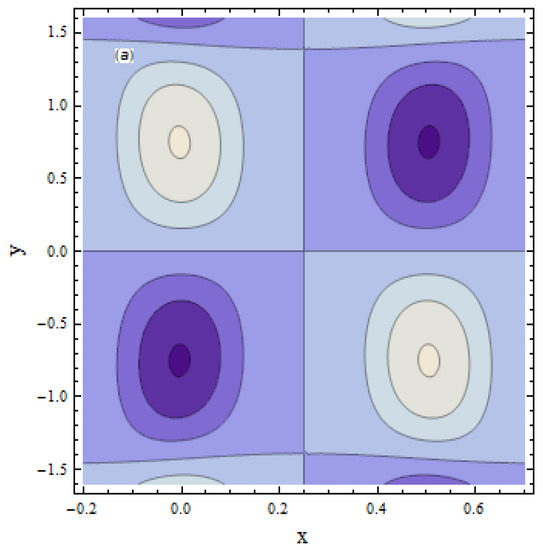
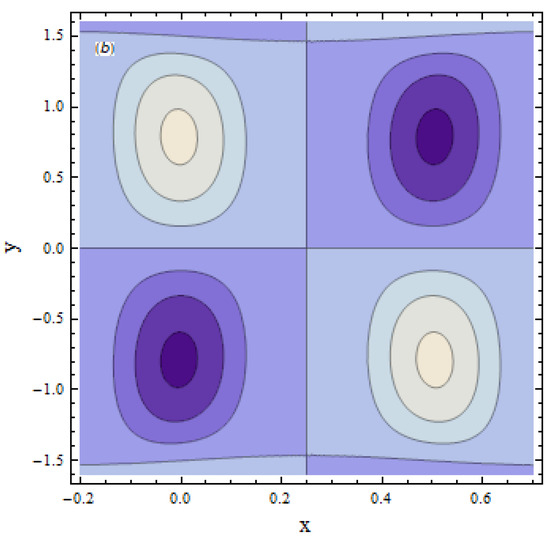
Figure 23.
ψ variation when (a) We = 0.1 and (b) We = 0.2.
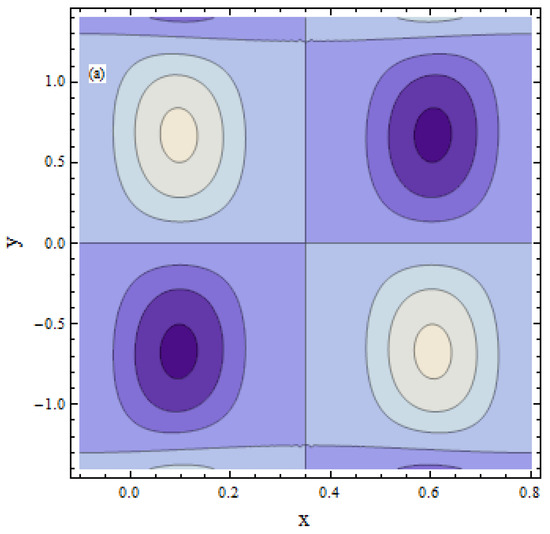
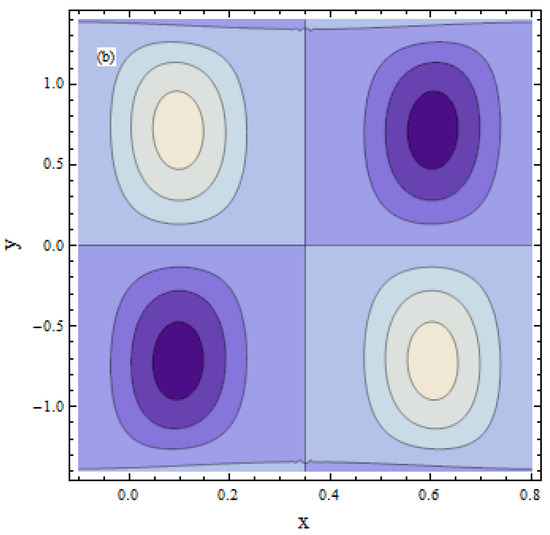
Figure 24.
ψ variation when (a) M = 0.3 and (b) M = 0.7.
5. Conclusions
The effects of motile gyrotactic micro-organisms on the bioconvection peristaltic flow of a nanofluid were studied. The non-Newtonian Carreau–Yasuda model was used in this study. The slip conditions impose on the elastic channel walls. The impacts of joule heating, viscous dissipation, and thermal radiation were also taken into account. The governing problem was solved numerically. The velocity of the fluid increases with increments in the velocity slip and thermal Grashof . The bioconvection Rayleigh and Peclet numbers have an inverse behavior on velocity. Temperature increases via Brownian motion and the Brinkmann number The behaviors of the radiation variable and the buoyancy ratio parameter on temperature are reversed. The motile micro-organisms decrease via the bioconvection Peclet number and thermophoresis variable. The rate of heat transfer increases via the Grashof number and the bioconvection Peclet parameter The concentration declines via the bioconvection Peclet number The results of Hayat et al. [13] are recovered when
Author Contributions
Conceptualization, Z.N. and H.Y.; methodology, Z.N.; software, Z.N.; validation, Z.N. and H.Y.; formal analysis, Z.N. and H.Y.; investigation, Z.N. and H.Y.; writing—original draft preparation, Z.N.; writing—review and editing, H.Y.; visualization, Z.N.; funding acquisition, H.Y. All authors have read and agreed to the published version of the manuscript.
Funding
This work was supported by the Deanship of Scientific Research, the Vice Presidency for Graduate Studies and Scientific Research, King Faisal University, Saudi Arabia (Grant No. 2478).
Institutional Review Board Statement
Not applicable.
Informed Consent Statement
Not applicable.
Data Availability Statement
Not applicable.
Conflicts of Interest
The authors declare no conflict of interest.
Nomenclature
| (x,y) | Cartesian co-ordinates |
| a | wave amplitude |
| c | wave speed |
| p | pressure |
| d | coefficient of viscous damping |
| n | power law index |
| C | concentration |
| (u,v) | velocity components |
| t | time |
| d1 | half channel width |
| g | gravitational acceleration |
| k | thermal conductivity |
| T | temperature |
| Wc | maximum cell swimming speed |
| Greek symbols | |
| α | thermal diffusivity |
| ρ | density, kg/m3 |
| σ | electric conductions |
| Γ | material constant |
| σ | electric conductions |
| λ | wave length |
| δ | wave number |
| (β1,β2,β3) | slip parameters |
| ψ | stream function |
References
- Latham, T. Fluid motion in a peristaltic pump. Master’s Thesis, Massachusetts Institute of Technology, Cambridge, UK, 1966. [Google Scholar]
- Shapiro, A.H.; Jaffrin, M.Y.; Weinberg, S.L. Peristaltic pumping with long wavelength at low Reynolds number. J. Fluid Mech. 1969, 37, 799–825. [Google Scholar] [CrossRef]
- Mekheimer, K.S. Effect of the induced magnetic field on peristaltic flow of a couple stress fluid. Phys. Lett. A 2008, 372, 4271–4278. [Google Scholar] [CrossRef]
- Ali, N.; Sajid, M.; Javed, T.; Abbas, Z. Heat transfer analysis of peristaltic flow in a curved channel. Int. J. Heat Mass Transf. 2010, 53, 3319–3325. [Google Scholar] [CrossRef]
- Mustafa, M.; Hina, S.; Hayat, T.; Alsaedi, A. Influence of wall properties on the peristaltic flow of a nanofluid: Analytic and numerical solutions. Int. J. Heat Mass Transf. 2012, 55, 4871–4877. [Google Scholar] [CrossRef]
- Hayat, T.; Iqbal, M.; Yasmin, H.; Alsaadi, F.E.; Gao, H. Simultaneous effects of Hall and convective conditions on peristaltic flow of couple-stress fluid in an inclined asymmetric channel. Pramana 2015, 85, 125–148. [Google Scholar] [CrossRef]
- Sinnott, M.D.; Cleary, P.W.; Harrison, S.M. Peristaltic transport of a particulate suspension in the small intestine. Appl. Math. Model. 2017, 44, 143–159. [Google Scholar] [CrossRef]
- Yasmin, H.; Iqbal, N.; Tanveer, A. Engineering applications of peristaltic fluid flow with hall current, thermal deposition and convective conditions. Mathematics 2020, 8, 1710. [Google Scholar] [CrossRef]
- Nisar, Z.; Hayat, T.; Alsaedi, A.; Ahmad, B. Significance of activation energy in radiative peristaltic transport of Eyring-Powell nanofluid. Int. Commun. Heat Mass Transf. 2020, 116, 104655. [Google Scholar] [CrossRef]
- Yasmin, H.; Iqbal, N.; Hussain, A. Convective heat/mass transfer analysis on Johnson-Segalman fluid in a symmetric curved channel with peristalsis: Engineering applications. Symmetry 2020, 12, 1475. [Google Scholar] [CrossRef]
- Hina, S.; Kayani, S.M.; Mustafa, M. Aiding or opposing electro-osmotic flow of Carreau–Yasuda nanofluid induced by peristaltic waves using Buongiorno model. Waves Random Complex Media 2022, 1–17. [Google Scholar] [CrossRef]
- Abbasi, F.M.; Shehzad, S.A. Magnetized peristaltic transportation of boron-nitride and ethylene-glycol nanofluid through a curved channel. Chem. Phys. Lett. 2022, 803, 139860. [Google Scholar]
- Hayat, T.; Nisar, Z.; Ahmad, B.; Yasmin, H. Simultaneous effects of slip and wall properties on MHD peristaltic motion of nanofluid with Joule heating. J. Magn. Magn. Mater. 2015, 395, 48–58. [Google Scholar] [CrossRef]
- Hayat, T.; Nisar, Z.; Yasmin, H.; Alsaedi, A. Peristaltic transport of nanofluid in a compliant wall channel with convective conditions and thermal radiation. J. Mol. Liq. 2016, 220, 448–453. [Google Scholar] [CrossRef]
- Rafiq, M.; Sajid, M.; Alhazmi, S.E.; Khan, M.I.; El-Zahar, E.R. MHD electroosmotic peristaltic flow of Jeffrey nanofluid with slip conditions and chemical reaction. Alex. Eng. J. 2022, 61, 9977–9992. [Google Scholar] [CrossRef]
- Choi, S.U.S. Enhancing Thermal Conductivity of Fluids with Nanoparticles; Siginer, D., Wang, H., Eds.; Developments and Applications of Non-Newtonian Flows; ASME FE Argonne National Laboratory: Argonne, IL, USA, 1995; Volume 231, pp. 99–105. [Google Scholar]
- Buongiorno, J.D. Convective transport in nanofluids. ASME J. Heat Transf. 2006, 128, 240–250. [Google Scholar] [CrossRef]
- Tsai, C.Y.; Chien, H.T.; Ding, P.P.; Chan, B.; Luh, T.Y.; Chen, P.H. Effect of structural character of gold nanoparticles in nanofluid on heat pipe thermal performance. Mater. Lett. 2004, 58, 1461–1465. [Google Scholar] [CrossRef]
- Li, Y.; Tung, S.; Schneider, E.; Xi, S. A review on development of nanofluid preparation and characterization. Powd. Techn. 2009, 196, 89–101. [Google Scholar] [CrossRef]
- Yan, Q.; Lu, J.; Ni, X.W. Measurement of the Velocities of Nanoparticles in Flowing Nanofluids using the Zero-Crossing Laser Speckle Method. Chin. Phys. Lett. 2012, 29, 044207. [Google Scholar] [CrossRef]
- Abbasi, F.M.; Hayat, T.; Ahmad, B. Peristaltic transport of copper–water nanofluid saturating porous medium. Physica E 2015, 67, 47–53. [Google Scholar] [CrossRef]
- Akram, S.; Afzal, Q.; Aly, E.H. Half-breed effects of thermal and concentration convection of peristaltic pseudoplastic nanofluid in a tapered channel with induced magnetic field. Case Stud. Therm. Eng. 2020, 22, 100775. [Google Scholar] [CrossRef]
- Bhatti, M.M.; Abdelsalam, S.I. Bio-inspired peristaltic propulsion of hybrid nanofluid flow with Tantalum (Ta) and Gold (Au) nanoparticles under magnetic effects. Waves Random Complex Media 2021, 1–26. [Google Scholar] [CrossRef]
- Alsaedi, A.; Nisar, Z.; Hayat, T.; Ahmad, B. Analysis of mixed convection and hall current for MHD peristaltic transport of nanofluid with compliant wall. Int. Commun. Heat Mass Transf. 2021, 121, 105121. [Google Scholar] [CrossRef]
- Abbasi, F.M.; Zahid, U.M.; Akbar, Y.; Saba, B.; Hamida, M.B. Thermodynamic analysis of electroosmosis regulated peristaltic motion of Fe 3 O 4-Cu/H 2 O hybrid nanofluid. Int. J. Modern Phys. B 2022, 36, 2250060. [Google Scholar] [CrossRef]
- Nisar, Z.; Hayat, T.; Alsaedi, A.; Ahmad, B. Mathematical modeling for peristalsis of couple stress nanofluid. Math. Meth. Appl. Sci. 2022, 1–19. [Google Scholar] [CrossRef]
- Hussain, A.; Wang, J.; Akbar, Y.; Shah, R. Enhanced thermal effectiveness for electroosmosis modulated peristaltic flow of modified hybrid nanofluid with chemical reactions. Sci. Rep. 2022, 12, 13756. [Google Scholar] [CrossRef]
- Yasmin, H.; Giwa, S.O.; Noor, S.; Sharifpur, M. Experimental exploration of hybrid nanofluids as energy-efficient fluids in solar and thermal energy storage applications. Nanomaterials 2023, 13, 278. [Google Scholar] [CrossRef] [PubMed]
- Singh, K.R.B.; Nayak, V.; Singh, R.P. Introduction to bionanomaterials: An overview. In Bionanomaterials Fundamentals and Biomedical Applications; IOP Publishing, Ltd.: Bristol, UK, 2021; pp. 1–21. [Google Scholar]
- Jeevanandam, J.; Ling, J.K.U.; Barhoum, A.; Chan, Y.S.; Danquah, M.K. Bionanomaterials: Definitions, Sources, Types, Properties, Toxicity, And Regulations, Fundamentals of Bionanomaterials. Micro Nano Technol. 2022, 15, 1–29. [Google Scholar]
- Hayat, T.; Abbasi, F.M.; Alsaedi, A.; Alsaadi, F. Hall and Ohmic heating effects on the peristaltic transport of a Carreau-Yasuda fluid in an asymmetric channel. Z. Naturforschung A 2014, 69, 43–51. [Google Scholar] [CrossRef]
- Kayani, S.M.; Hina, S.; Mustafa, M. A new model and analysis for peristalsis of Carreau-Yasuda (CY) nanofluid subject to wall properties. Arab. J. Sci. Eng. 2020, 45, 5179–5190. [Google Scholar] [CrossRef]
- Khan, M.I.; Alzahrani, F.; Hobiny, A.; Ali, Z. Estimation of entropy generation in Carreau-Yasuda fluid flow using chemical reaction with activation energy. J. Mater. Res. Techn. 2020, 9, 9951–9964. [Google Scholar] [CrossRef]
- Nisar, Z.; Hayat, T.; Alsaedi, A.; Momani, S. Peristaltic flow of chemically reactive Carreau-Yasuda nanofluid with modified Darcy’s expression. Mater. Today Commun. 2022, 33, 104532. [Google Scholar] [CrossRef]
- Iqbal, J.; Abbasi, F.M. Analysis of entropy generation for Magnetohydrodynamics peristaltic motion of Carreau-Yasuda nanofluid through a curved channel with variable thermal conductivity and Joule heating. Waves Random Complex Media 2022, 1–20. [Google Scholar] [CrossRef]
- Pedley, T.J.; Hill, N.A.; Kessler, J.O. The growth of bioconvection patterns in a uniform suspension of gyrotactic micro-organisms. J. Fluid Mech. 1988, 195, 223–237. [Google Scholar] [CrossRef] [PubMed]
- Waqas, H.; Khan, S.U.; Hassan, M.; Bhatti, M.M.; Imran, M. Analysis on the bioconvection flow of modified second-grade nanofluid containing gyrotactic microorganisms and nanoparticles. J. Mol. Liq. 2019, 291, 111231. [Google Scholar] [CrossRef]
- Rao, M.; Gangadhar, K.; Chamkha, A.J.; Surekha, P. Bioconvection in a convectional nanofluid flow containing gyrotactic microorganisms over an isothermal vertical cone embedded in a porous surface with chemical reactive species. Arab. J. Sci. Eng. 2021, 46, 2493–2503. [Google Scholar] [CrossRef]
- Hayat, T.; Nisar, Z.; Alsaedi, A. Bioconvection and Hall current analysis for peristalsis of nanofluid. Int. Commun. Heat Mass Transf. 2021, 129, 105693. [Google Scholar] [CrossRef]
- Hussein, S.A.; Ahmed, S.E.; Arafa, A.A. Electrokinetic peristaltic bioconvective Jeffrey nanofluid flow with activation energy for binary chemical reaction, radiation and variable fluid properties. Z. Angew. Math. Mech. 2022, 103, e202200284. [Google Scholar] [CrossRef]
- Akbar, Y.; Huang, S. Enhanced thermal effectiveness for electrokinetically driven peristaltic flow of motile gyrotactic microorganisms in a thermally radiative Powell Eyring nanofluid flow with mass transfer. Chem. Phys. Lett. 2022, 808, 140120. [Google Scholar] [CrossRef]
- Avramenko, A.; Kovetska, Y.Y.; Shevchuk, I.V. Lorenz approach for analysis of bioconvection instability of gyrotactic motile microorganisms. Chaos Solit. Fractals 2023, 166, 112957. [Google Scholar] [CrossRef]
- Gad-el-Hak, M. Compliant coatings: The simpler alternative. Exp. Therm. Fluid Sci. 1998, 16, 141–156. [Google Scholar] [CrossRef]
- Gad-El-Hak, M. Drag Reduction Using Compliant Walls. In Flow Past Highly Compliant Boundaries and in Collapsible Tubes. Fluid Mechanics and Its Applications; Carpenter, P.W., Pedley, T.J., Eds.; Springer: Dordrecht, The Netherlands, 2003; p. 72. [Google Scholar]
- Kramer, M.O. Boundary-layer stabilization by distributed damping. J. Aeronaut. Sci. 1957, 24, 459–460. [Google Scholar]
Disclaimer/Publisher’s Note: The statements, opinions and data contained in all publications are solely those of the individual author(s) and contributor(s) and not of MDPI and/or the editor(s). MDPI and/or the editor(s) disclaim responsibility for any injury to people or property resulting from any ideas, methods, instructions or products referred to in the content. |
© 2023 by the authors. Licensee MDPI, Basel, Switzerland. This article is an open access article distributed under the terms and conditions of the Creative Commons Attribution (CC BY) license (https://creativecommons.org/licenses/by/4.0/).